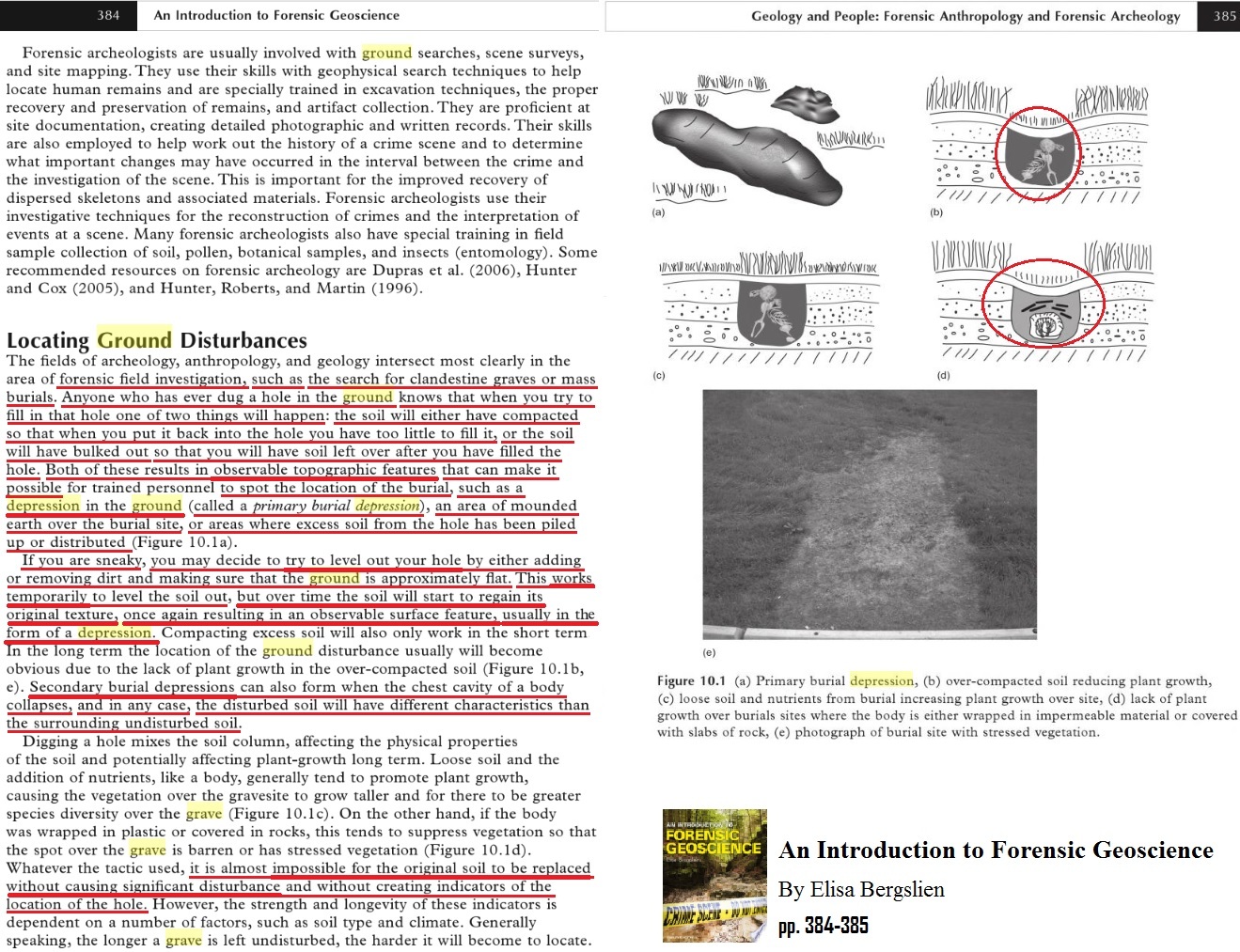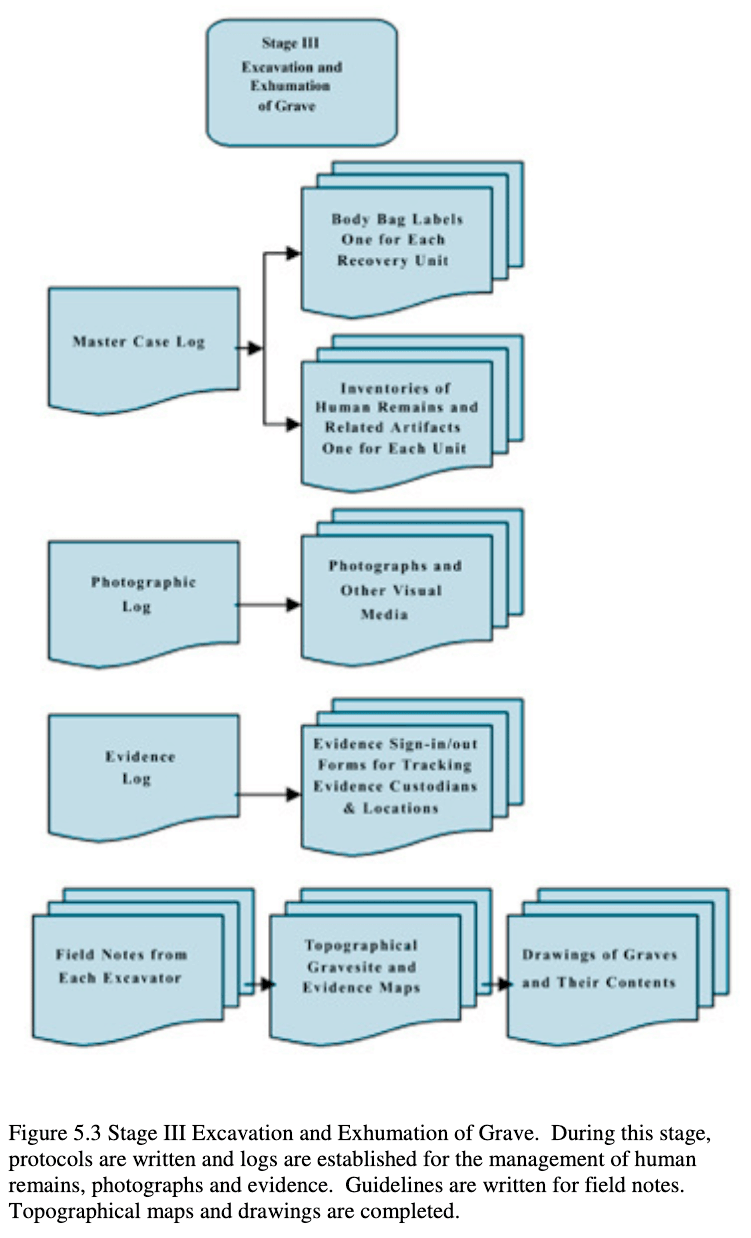Exterminationists tend to argue that huge mass graves were actually proven to exist at three of the Operation Reinhardt "Extermination camps": Sobibor, Belzec, and Treblinka II. It is estimated by exterminationists that 1.5-2 million people, virtually all gassed Jews, were burned in giant outdoor pyres and buried at these three camps. It is also claimed that within the past 20 years, so-called "Excavations" have taken place at these camps which have proven that there are enormous quantities of human remains there consistent with the figures they propose. Despite this, somehow we are not provided photographs from any of these excavations showing 1%, or even 0.1% of the alleged human remains claimed to exist.
Some exterminationists argue that mass grave excavations are not done by digging up the bones and photographing them; this is completely wrong. Archaeologists do indeed use other tools like ground penetrating radars and core samples in these instances, but this is to ensure that they have a probable burial site so they do waste time digging holes everywhere and only finding dirt.
Anyway, on to the article, which is about scientists making their own mass graves to study the subject:
That was only a few excerpts, much more here:Body of Evidence: UT using donated corpses in mass grave project with international aspirations
Researchers hope to dig up secrets of buried bones
By Megan Boehnke
Posted April 14, 2013 at 4 a.m.
University of Tennessee anthropology graduate students Katie Corcoran and Kyle McCormick pause from digging four graves at the University of Tennessee’s Forensic Anthropology Center in February. The mass-grave research project will observe 10 bodies for three years, detecting changes in the ground and looking at multispectral imagery.
Researchers wanted to bury the 10 bodies on the south bank of Fort Loudoun Lake. They had to do it by hand. The brush, though bare in winter, was too dense and too sloped for machines. Instead, scientists in February cleared a path leading to the spot where, shovel by shovel, they dug four holes. One grave now holds the piled remains of six people. Another holds three, and another a single body. A fourth was dug out and then refilled only with dirt, a control for the experiment. For the next three years University of Tennessee scientists will monitor these fresh burial sites from the sky, from the ground, through sampling and in different light spectrums to determine if the mass graves can be detected from afar.
...
Exposing atrocities
Evidence of the horrors humans commit against each other exists in nearly every region of the world.
...
Some investigators already use before-and-after satellite images and ground-penetrating radar to find clues about possible graves, said Stefan Schmitt, director of the international forensic program with the U.S.-based Physicians for Human Rights. “Remote sensing has always been a really big interest, especially as technology becomes more and more accessible,” Schmitt said. “But the problem is that it’s not definitive. You can show me the picture, and I can’t say anything until I get in there and dig a hole.
“Technology has always been limited by that step where you have to go in, and that makes a difference in places like Darfur (in Sudan) or Syria or other places where there are allegations of mass graves.” UT researchers concede there may never be certainty that the blips that show up in the images are human graves. But they hope that by using multiple kinds of technology, they can at least predict them with higher probability.
...
One technology, LiDAR, which is short for Light Detection and Ranging, uses a laser to trace the contours on the ground and look for subtle elevation changes. Initially, mass graves appear as mounds after they’re dug, but over time, as the human remains decompose, depressions form in the ground. The other technology, multi-spectral imagery, can look at what’s being reflected off the ground in different light spectra, such as blue, green, red, infrared and so forth. Different materials are reflected across the spectrum with specific signatures, said Katie Corcoran, a lead graduate student at UT who is using the project for her dissertation.
“If you know vegetation looks a certain way, but in this image it looks different, maybe that’s because it’s disturbed,” Corcoran said. “And then on top of that is a layer of LiDAR data that shows an elevation difference, maybe a mound or a depression, and it happens to be the same spot. You can say maybe that this is a manmade disturbance. I don’t think we’ll ever be able to say this is a grave.”
...
https://archive.is/wMjeh or http://web.archive.org/web/201304170535 ... orpses-in/
So it is quite obvious in the above quoted article that to actually prove a mass grave you must excavate the remains. Merely taking ground-penetrating radar scans is not enough.
Some info on ground disturbances:

Another study here describes the archeology of mass graves, and gives guidelines to use in forensically documenting the excavations to be used in court cases. Naturally, actual excavations of the area must take place, the other tools used are only to help locate potential graves. They also are explicitly clear about photographing the actual excavations:
The Archaeology of Contemporary Mass Graves https://www.jstor.org/stable/25616893
Once the potential grave is located, the surrounding area should be searched for additional evidence and the grave should be documented with photographs and with a map (Gerberth 1983:86)...
Before any soil disturbance, the site needs to be thoroughly documented. This includes photographing the entire area and creating a map showing the surface contours of the area of the grave...
The final product of the testing should include a map showing the site area, trenches, human remains, grave pit, and depth of the top layer of bodies. Products will also include a photographic record of the process, a photographic log, and an evidence log...
When the team is ready to begin body removal, the ideal excavation is large enough that the entire grave is exposed and trenches are excavated around the sides so that the edges are well delimited. At this point, photographic documentation is again important as is plotting the edges of excavation and the edges of the grave.
The UN provides guidelines for mass grave excavations, some excerpts are provided:
United Nations Manual on the Effective Prevention and Investigation of Extra-Legal, Arbitrary and Summary Executions https://archive.is/ER3DO
B. Proposed model skeletal analysis protocol
1. Scene investigation
....
(c) Photograph the work area from the same perspective before work begins and after it ends every day to document any disturbance not related to the official procedure
...
(h) Remove the overburden of earth, screening the dirt for associated materials. Record the level (depth) and relative co-ordinates of any such findings. The type of burial, especially whether primary or secondary, influences the care and attention that needs to be given to this step. Associated materials located at a secondary burial site are unlikely to reveal the circumstances of the primary burial but may provide information on events that have occurred after that burial;
...
(j) Circumscribe the body, when the level of the burial is located, and, when possible, open the burial pit to a minimum of 30 cm on all sides of the body;
...
(l) Expose the remains with the use of a soft brush or whisk broom. Do not use a brush on fabric, as it may destroy fibre evidence. Examine the soil found around the skull for hair. Place this soil in a bag for laboratory study. Patience is invaluable at this time. The remains may be fragile, and interrelationships of elements are important and may be easily disrupted. Damage can seriously reduce the amount of information available for analysis;
(m) Photograph and map the remains in situ. All photographs should include an identification number, the date, a scale and an indication of magnetic north;
(i) First photograph the entire burial, then focus on significant details so that their relation to the whole can be easily visualized; ...
From chapter 5 of the book entitled "Forensic Archaeology: Advances in Theory and Practice" which Amazon.com describes as "a textbook universally hailed as an indispensable guide" and "a complete introduction to the methods and means of forensic archaeology":
The Archaeology of Mass graves
This chapter is about the archaeology of mass graves...
Any examination of a mass grave will require excavation, but not all excavations will require exhumation. The archaeological examination is just one step in the process of determining the cause and manner of death, or other forensic issues including dating, or identity. The pathologists may require all, or merely some, of the bodies to be removed to a morgue, and may even be happy to examine the bodies within the grave itself...
Photographs taken of the state of work at the end of each day can assist in the writing of the report, and it is also important to photograph the state of the site at the start of each day’s work, to prove that no tampering with the evidence has taken place during the team’s absence overnight and at weekends...
The principles applied to setting up a conventional excavation can be extended to the excavation of a mass grave... Very roughly, and under favourable soil and groundwater conditions, about two bodies can be removed by one person per day. This rate of removal assumes that the bodies are cleaned, photographed and surveyed before removal. In addition to excavators, the team will need the services of staff experienced in archaeological surveying and an understanding of crime scene photography. Each body needs to be photographed, with appropriate documentation, at the critical point between cleaning and lifting....
http://archive.vn/8J0YW or http://web.archive.org/web/202006232253 ... ology.html
The difference here between excavate and exhume is that to excavate is to dig the hole and actually show the remains, but exhuming them means to remove the remains from the location. Ergo, to actually prove a mass grave exists in a place, you must actually dig the earth out and have the bodies physically showing, but you do not always have to actually remove them from the graves. Additionally, it is standard practice, based on UN guidelines, to photograph the site constantly and any excavated graves consistently. Every single source I have found discussing mass grave excavations has been extremely explicit on this point. For a proper mass grave excavation to occur ("proper" as in held to the standards of a court of law, or as valid archaeological findings) you not only have to take photos of the remains, you have to photograph everything, every day, multiple times per day. You have to take specific photographs -- or rather document specific things with the photographs: time, date, orientation of the photograph (cardinal direction) -- and much more.
Why don't we see anything like this for the so-called "Holocaust" mass graves at the AR camps?
All we get is some "Reports" of "excavations" with no photographs of massive pits, or if we do they are nowhere near even 0.1% of the alleged remains. At Belzec we get DRAWINGS of core samples.
Here are some examples from Google image search of real mass grave excavations, unrelated to the "Holocaust" that produce photographs of human remains: https://google.com/search?q=mass+grave+ ... s&tbm=isch
Legitimate, forensically documented, verifiably honest mass grave excavations produce numerous photographs of the human remains. There are no exceptions, ever.



